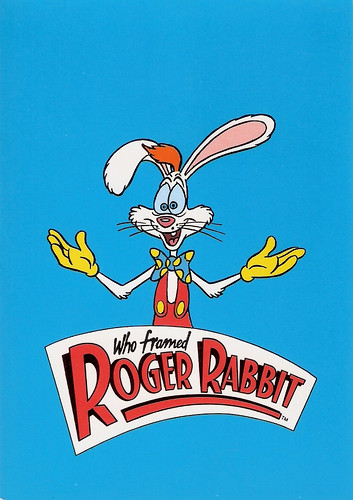
Belgian postcard by Rozenco, Brussels. Image: The Walt Disney Company / Amblin Entertainment, 1987. Publicity for Who Framed Roger Rabbit (Robert Zemeckis, 1988).

Belgian postcard by Rozenco, Brussels. Image: The Walt Disney Company / Amblin Entertainment, 1987. Publicity for Who Framed Roger Rabbit (Robert Zemeckis, 1988).
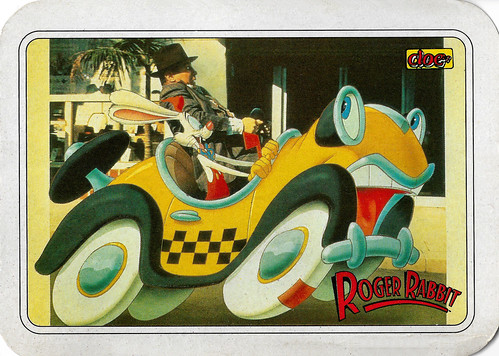
Italian postcard by Edizioni Cioe', Torino. Bob Hoskins in Who Framed Roger Rabbit (Robert Zemeckis, 1988).
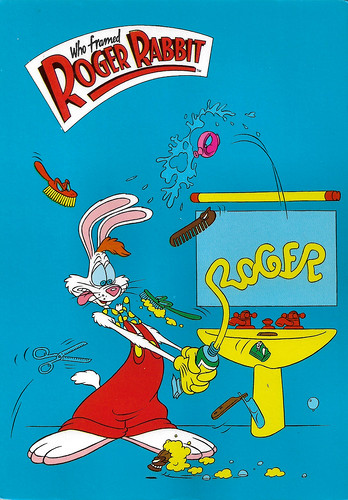
Belgian postcard by Rozenco, Brussels. Image: The Walt Disney Company and Amblin Entertainment Inc. Publicity for Who Framed Roger Rabbit (Robert Zemeckis, 1988).
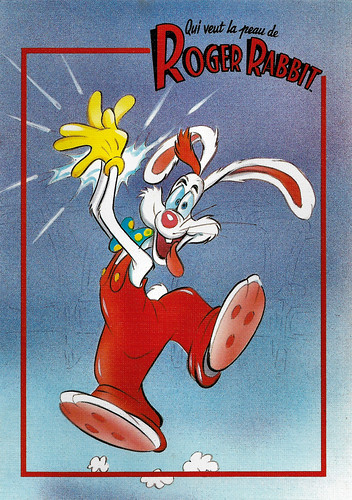
French postcard by M.D., Paris, no. D 630, 5/3. Image: Disney. Publicity for Who Framed Roger Rabbit (Robert Zemeckis, 1988). The French film title is Qui veut la peau de Roger Rabbit.
The Culprit of Toontown
Who Framed Roger Rabbit (Robert Zemeckis, 1988) is set in 1947 in Los Angeles. In the reality in which the film is set, cartoon characters called "Toons" live in the same world as "real" characters.
A part of Los Angeles is given entirely to them and is known as Toontown. They earn their living by acting in cartoons. One of the best-known Toons is the rabbit Roger Rabbit, who is the star of his cartoon series.
Lately, however, he has been unable to concentrate on his work. To find out why, R.K. Maroon, the studio boss and owner of Maroon Cartoons, hires cranky private detective Eddie Valiant (Bob Hoskins). Eddie was once one of Hollywood's best-known detectives. He and his brother Teddy helped hundreds of Toons with their problems.
Since Teddy was murdered by a Toon several years ago, Eddie has started drinking heavily and harbours a deep antipathy towards cartoon characters. He therefore reluctantly takes the job because he needs money to repay his debt to his barmaid and friend Dolores.
Soon, Eddie obtains photographic evidence that Roger's wife, Jessica Rabbit (who, unlike her name suggests, is not a rabbit but drawn as a human), is having an "affair" with Marvin Acme, the owner of the Acme Company and Toontown. When Roger discovers this, he is furious and vows to get his wife back. The next day, Marvin turns out to have been murdered, and Roger appears to be the culprit.
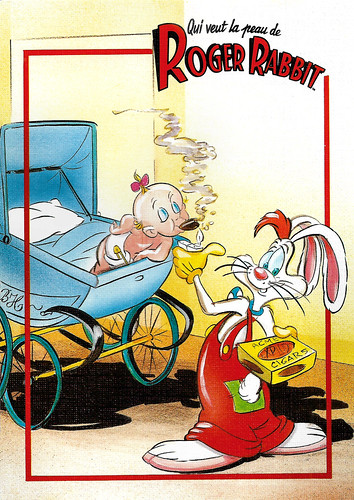
French postcard by M.D., Paris, no. D 630, 5/2. Image: Disney. Publicity for Who Framed Roger Rabbit (Robert Zemeckis, 1988). The French film title is Qui veut la peau de Roger Rabbit.
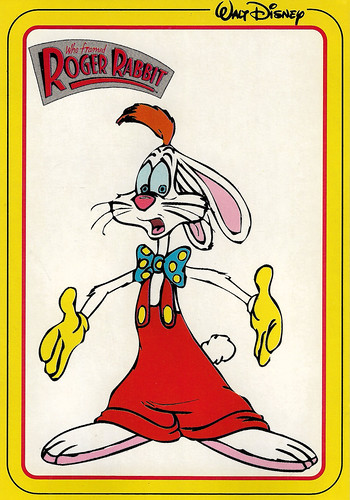
Italian postcard by Grafiche Biondetti S.R.L., Verona, no. 148/1. Image: Walt Disney. Publicity for Who Framed Roger Rabbit (Robert Zemeckis, 1988).

Italian postcard by Grafiche Biondetti S.R.L., Verona, no. 148/2. Image: Walt Disney. Publicity for Who Framed Roger Rabbit (Robert Zemeckis, 1988).
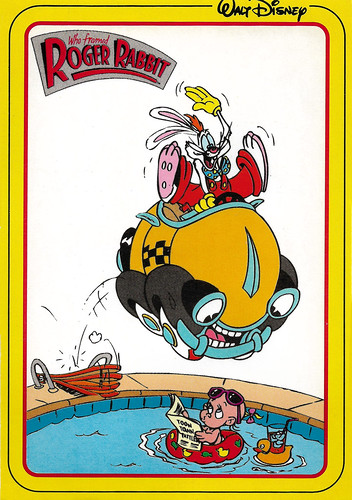
Italian postcard by Grafiche Biondetti S.R.L., Verona, no. 148/3. Image: Walt Disney. Publicity for Who Framed Roger Rabbit (Robert Zemeckis, 1988).
A homage to the cartoons of the 1940s
Who Framed Roger Rabbit (Robert Zemeckis, 1988) was inspired by the novel 'Who Censored Roger Rabbit?' which Disney had bought the rights to in 1981. Disney films had not been successful for some time and the company had seriously considered quitting. However, this film would change that.
Steven Spielberg managed to convince rival studios to let their cartoon characters act together in the same film. The condition was that they would be positioned equally. The live-action scenes were directed by Robert Zemeckis. The indoor scenes were mostly shot at the Cannon Elstree film studios in Hertfordshire, England. The outdoor scenes were shot on location in Los Angeles.
Although Disney was the studio behind the film, most of the animation was done in London. More than 100 individual pieces of film were optically combined to combine the animated and live-action scenes. The animated characters were drawn by hand and analogue optical effects such as shadows were added afterwards to give the cartoon characters a more 3D look.
The film was made at a time when digital animation was in its infancy. It was considered to make use of this but as the film was to be an homage to the cartoons of the 1940s (its heyday), hand-drawn cartoons were chosen. Walt Disney had already made a hybrid animation film (a combination of animation and live-action) with Mary Poppins (Robert Stevenson, 1964), but in this film, the scenes were very limited.
With Roger Rabbit, they went a step further. Almost half of the film consisted of hybrid scenes, there was much more physical interaction between people, cartoon characters and objects, and to make it even more difficult, the camera did not stay in a fixed position but moved along with the scenes. Who Framed Roger Rabbit was a huge success and made animated films popular again with the general public.

Italian postcard by Grafiche Biondetti S.R.L., Verona, no. 148/4. Image: Walt Disney. Publicity for Who Framed Roger Rabbit (Robert Zemeckis, 1988).
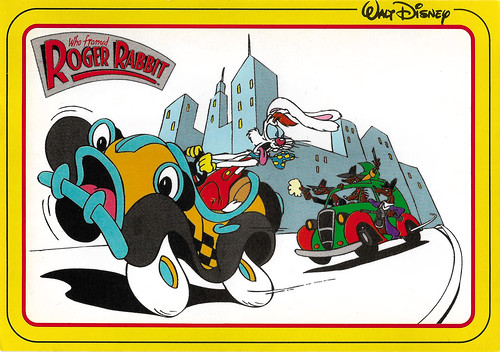
Italian postcard by Grafiche Biondetti S.R.L., Verona, no. 148/5. Image: Walt Disney. Publicity for Who Framed Roger Rabbit (Robert Zemeckis, 1988).

Italian postcard by Grafiche Biondetti S.R.L., Verona, no. 148/6. Image: Walt Disney. Publicity for Who Framed Roger Rabbit (Robert Zemeckis, 1988).
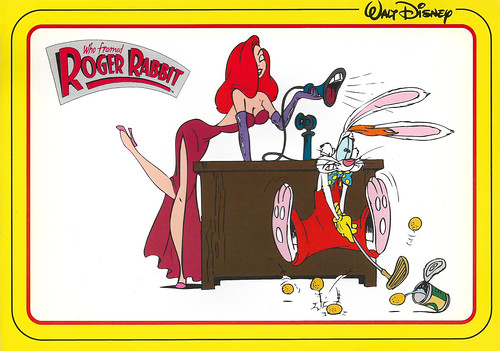
Italian postcard by Grafiche Biondetti S.R.L., Verona, no. 32. Image: Walt Disney. Publicity for Who Framed Roger Rabbit (Robert Zemeckis, 1988).

Italian postcard by Grafiche Biondetti S.R.L., Verona, no. 148/8. Image: Walt Disney. Publicity for Who Framed Roger Rabbit (Robert Zemeckis, 1988).
Sources: Wikipedia (Dutch and English) and IMDb.
No comments:
Post a Comment